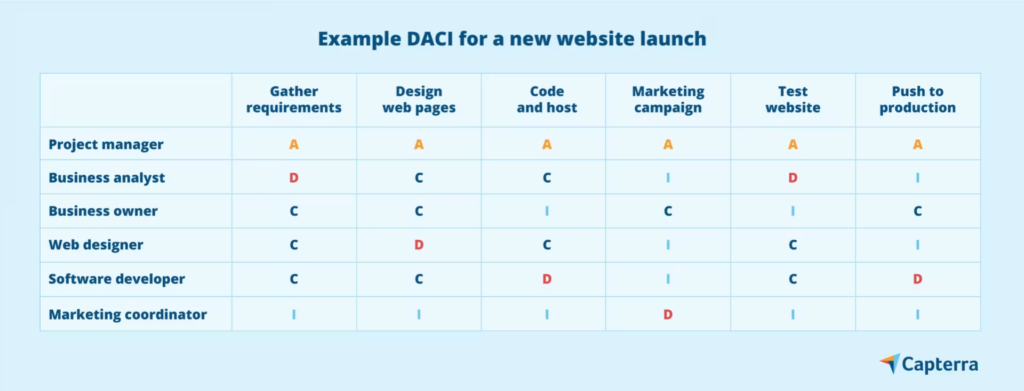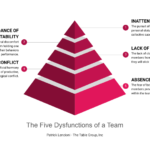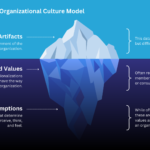Imagine this (or maybe you don’t need to), a team is sitting in front of their computers, ready for a Zoom meeting. As they look at their screens with a latest numbers in a presentation, figures glaringly short of the set targets. Right away – a room is filled with silence, few cameras turning off and others just frozen. As a minute passes, one brave soul declares, “That part wasn’t my responsibility”, their voice echoing through the speakers, “I was held up because I didn’t get the information I needed from sales” another counters. Soon the virtual space is filled with a excuses and finger-pointing. This back-and-forth blame keeps going, making it hard for anyone to figure out how to fix the problem. No one wants to say it’s their fault. It’s a situation many of us have seen before during online meetings. Have you ever found yourself in a similar situation, wondering how things could have been different with clear ownership?
This scenario underscores a pervasive issue in project management—the lack of clear ownership. When outcomes are murky, and responsibilities blurred, projects often veer off course, culminating in a mire of blame rather than productive resolution. This highlights the necessity of establishing unequivocal ownership in project management, moving away from the blame game towards a culture of accountability and success.
Why Clear Ownership Matters
The cornerstone of any successful project is clarity in ownership. When individuals are designated as directly responsible for specific tasks or outcomes—known as Directly Responsible Individuals (DRIs)—it engenders a sense of accountability and dedication to the project’s success. This clear allocation of ownership ensures that every team member knows precisely what is expected of them, reducing ambiguities that often lead to the blame game.
Apple’s introduction of the DRI model was a game-changer in project management. As detailed in Fortune’s article on Apple’s operational strategies, the DRI is the person with whom “the buck stops” regarding any given project. This clear delineation of responsibility ensures that every project has a singular point of accountability, which simplifies decision-making and problem-solving processes.
At the core of the DRI model is a commitment to results and efficiency. The assignment of a DRI to a project removes ambiguity about decision-making authority, streamlining the project’s progression. Contrary to the belief that a single point of responsibility might hinder collaboration, the DRI model actually fosters a more cooperative environment. DRIs are encouraged to be fully invested in their projects and to seek input and collaboration actively. They hold the final decision-making power but are also expected to leverage the expertise and judgment of their team members.
This approach aligns with the foundational values of accountability and dedication, following are just some of the clear benefits to this approach,
- Enhances Accountability: When a DRI is assigned, they become the point person for that task or outcome, fostering a deep sense of responsibility and personal investment in the project’s success.
- Streamlines Communication: Clear ownership simplifies communication channels. Team members know whom to approach for updates or to address issues, thereby reducing misunderstandings and inefficiencies.
- Improved Collaboration: By knowing who is responsible for what, team members can collaborate more effectively, with a clear understanding of how their contributions fit into the larger project goals.
- Facilitates Decision-Making: DRIs have the authority to make decisions related to their areas of responsibility, which accelerates the decision-making process and ensures agile project progression.
- Improves Problem-Solving: With clear ownership, DRIs are more attuned to the intricacies of their tasks, enabling them to identify and address problems more swiftly and effectively.
- Boosts Team Morale: Assigning DRIs can lead to a more engaged and motivated team. Individuals take pride in ownership, which can enhance overall team morale and productivity.
How to Implement Effective Ownership Allocation
To cultivate an environment where ownership is clearly defined and embraced, organizations must:
- Define Roles and Responsibilities: From the outset of the project, explicitly outline who is responsible for what.
- Empower DRIs: Ensure that DRIs have the resources, authority, and support needed to fulfill their responsibilities effectively.
- Foster a Culture of Accountability: Encourage an organizational culture where accountability is valued and recognized. This includes celebrating successes and constructively addressing challenges.
- Regular Check-ins: Implement regular status updates and check-ins to monitor progress, address any obstacles DRIs may face, and realign on objectives as necessary.
Implementing effective ownership allocation in project management is essential for ensuring clarity, accountability, and success. Here’s how three distinct frameworks—DACI, RACI, and RAPID—can be effectively employed to delineate responsibilities and empower Directly Responsible Individuals (DRIs) within any organization:
RACI Model: Streamlining Project Responsibilities

RACI is an acronym for Responsible, Accountable, Consulted, and Informed, focusing on task assignment and project roles.
- Responsible: Individuals or teams tasked with performing the work. There can be multiple people responsible, but tasks are clearer when fewer hands are involved.
- Accountable: The single DRI who ultimately answers for the task’s completion. This person delegates tasks and ensures they’re completed satisfactorily.
- Consulted: Those whose opinions are sought typically subject matter experts with two-way communication.
- Informed: People who are kept updated on progress but do not contribute directly to the task execution.
When to Use:
- Project Management: Essential for projects that involve multiple tasks and teams, where it’s crucial to define who is responsible for what.
- Clarifying Roles and Responsibilities: Best used in scenarios where there is confusion about task ownership, and there’s a need to clarify who does what.
- Cross-Functional Collaboration: Ideal for projects that require cooperation across different departments, ensuring everyone understands their specific roles without overstepping.
RACI is most beneficial in environments where detailed task management and clear communication channels are necessary to prevent overlap and ensure that all aspects of a project are covered without ambiguity. It ensures everyone knows who is doing what, who needs to be consulted, and who should be informed, reducing the risk of miscommunication and overlooked responsibilities.
Further reading:
DACI Framework: Enhancing Decision-Making Clarity

DACI stands for Decision Maker, Accountable, Contributors, and Informed. It is specifically designed to clarify decision-making roles within projects.
- Decision Maker: Identifies the single individual responsible for making a decision, ensuring decisions are made swiftly and effectively.
- Accountable: Points to the person who is accountable for the overall success or failure of the decision, ensuring there’s always someone who owns the outcome.
- Contributors: Are those who provide input or information necessary for the decision. Their role is crucial in supplying the decision-maker with all relevant data.
- Informed: Consists of stakeholders who need to be kept in the loop about the decision but are not directly involved in making it.
When to Use:
- Complex Decision-Making: Ideal for projects where decisions require input from various contributors but still need a clear, single decision-maker.
- High-Level Projects: Useful in situations where strategic decisions impact multiple departments or the entire organization, necessitating a broad range of inputs.
- Innovation-Driven Initiatives: When projects are highly innovative, requiring creative input and a clear path to decision-making to explore new ideas effectively.
DACI is particularly effective when a project’s success hinges on critical decisions that must be made efficiently, with input from a diverse set of contributors. This framework ensures that every decision has a clear owner (the DRI), supported by a structured team that contributes to and is informed about outcomes. By defining these roles, DACI prevents ambiguity in decision-making processes, ensuring all members know their exact responsibilities.
Further reading:
RAPID Framework: Facilitating Agile Decision-Making

RAPID is a framework aimed at clarifying who is involved in decisions within an organization, consisting of Recommend, Agree, Perform, Input, and Decide roles.
- Recommend: Individuals who recommend actions or propose decisions based on their knowledge or analysis.
- Agree: Stakeholders who must agree to a decision before it moves forward, ensuring that all necessary approvals are obtained.
- Perform: The people who carry out the decision once it’s made, similar to the Responsible role in RACI.
- Input: Those who provide input based on expertise or stakeholder needs, contributing to the information that leads to a decision.
- Decide: The single individual, the DRI, who has the final say in the decision, ensuring accountability and clarity in who makes the call.
When to Use:
- Agile Decision-Making: Suited for dynamic environments where decisions need to be made quickly to adapt to changing conditions.
- Leadership and Strategic Planning: Useful in settings where leadership needs to make swift, strategic decisions with input from key stakeholders.
- Streamlining Processes: When the goal is to reduce bottlenecks in decision-making processes, particularly in larger organizations or complex projects.
RAPID excels in scenarios where speed and clarity in decision-making are paramount. It delineates who needs to be involved at each stage of the decision. It streamlines the decision-making process by explicitly defining the roles involved, thereby facilitating faster, more coherent, and accountable project management.
Selecting the right framework—DACI, RACI, or RAPID—depends on the specific challenges and goals of your organization or project. DACI is excellent for complex decision-making with many contributors; RACI shines in projects needing clear task ownership across teams; and RAPID is best for fast-paced environments requiring quick, decisive action. Understanding the strengths and applications of each can help managers and leaders effectively implement the most suitable framework, thereby enhancing project outcomes, team collaboration, and overall organizational efficiency.
Further reading:
Final Thoughts: Embracing the Power of Defined Ownership
The establishment of clear ownership through the assignment of Directly Responsible Individuals (DRIs) is not just beneficial but essential for the triumphant execution of projects. It instills a profound sense of accountability and dedication, transforming how tasks are approached and completed. This deliberate delineation of duties not only curtails the propensity for finger-pointing but also ensures that every team member is precisely informed of their expected contributions. Through the DRI framework, project management becomes an endeavor marked by precision in decision-making and a collaborative spirit that is both purposeful and results-driven.
What you, as a leader, must do is recognize the transformative potential of implementing the DRI model within your organizational or project framework. It’s about leveraging the power of individual responsibility and collective teamwork to create an environment where ownership is clearly defined, and success is a shared objective. The model is a beacon for navigating the complexities that today’s project management landscapes present, proving itself as an indispensable strategy for achieving outstanding results, optimizing operational efficiency, and nurturing an ethos of mutual respect and collaboration.
Incorporating the DRI model, along with frameworks like DACI, RACI, and RAPID, depending on the specific needs of your project or organization, will not only streamline workflows but also enhance the quality of outcomes achieved. This approach is your stepping stone towards fostering a culture where clarity, accountability, and excellence are not just envisioned but actively realized. As you move forward, let the principles of clear ownership and responsibility guide your strategies, enabling you and your team to reach new heights of project success and organizational growth.

